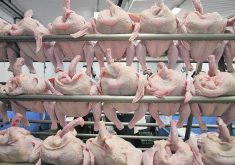We are all familiar with “shrinkflation,” in which the quantity of a product decreases while the price remains the same, and “shelflation,” in which a product’s shelf life is compromised due to supply chain issues.
These phenomena, which have been around for decades, contribute to the rising cost of groceries.
However, a new trend called “stretchflation” appears to be emerging in our grocery stores.
Read Also

High prices see cow-calf producers rushing to incorporate
Farm accountants are reporting a steady stream of cow-calf producers rushing to get their operations incorporated ahead of selling their calves this fall.
Stretchflation, first reported in Europe, involves increasing the quantity of a product while its price rises disproportionately, subtly deceiving consumers.
An unverified example is Saputo’s sliced provolone at Costco. The package size increased from 620 grams to 750 grams, a 20 per cent increase. However, the price of the 750 grams is more than $15, representing more than a 25 per cent increase, according to some reports.
Recently, some bakery products have also experienced similar price and quantity adjustments.
For now, cases of stretchflation are rare in our grocery aisles, but we might see more in the future. The recent consumer revolt against shrinkflation is pushing manufacturers and distributors to offer more product, but they also seem to be asking for more money in return.
The common denominator of all these strategies is the rising cost of raw materials. For example, sugar is about 50 per cent more expensive than five years ago, and cocoa prices have surged by 103 per cent. Orange juice prices are at a record high.
Some ingredients always experience a price surge for one reason or another. Sometimes, ingredients increase wildly, or prices fluctuate enormously, as seen with wheat and other commodities at the beginning of Russia’s invasion of Ukraine in 2022. Manufacturers need to adjust to maintain their market share.
However, stretchflation is different.
The primary motivation behind stretchflation is likely to defend the industry’s image, not just to cut costs and offer less.
Bulk buying was the trend for about 20 years, starting from the inflationary phase of the early 1980s. “Big was king,” as the saying goes.
Since then, there have been two significant shrinkflation cycles: in 2008-09 and more recently, from 2022 to now. The recent cycle of shrinkflation probably ended earlier this year, but the industry’s response seems to be stretchflation.
One might wish to legislate against companies changing product quantities, but that could lead to further price increases. And there’s nothing illegal about it.
Nevertheless, these tactics are a nuisance for all of us. The most concerning aspect of these quantity changes is their effect on our bills and how Statistics Canada measures their impact on food inflation. While the federal agency assures us that it monitors these strategies’ effects on food inflation, it rarely provides clear examples of how it adjusts its methodology to account for them.
Another issue is retail sales taxes. Many food products lose their tax-exempt status if the quantity is reduced too much. For example, this is the case for ice cream, puddings and granola bars.
Reading the rules on what is taxable or not at the grocery store is complicated. With quantity changes, many products become taxable simply because the quantity has been reduced, or vice versa.
Besides the desire to legislate against these tactics, the lack of transparency on our grocery bills regarding taxes is probably the most pressing issue that needs to be addressed.
Sylvain Charlebois is senior director of the agri-food analytics lab and a professor in food distribution and policy at Dalhousie University. This article first appeared on the Troy Media website.















